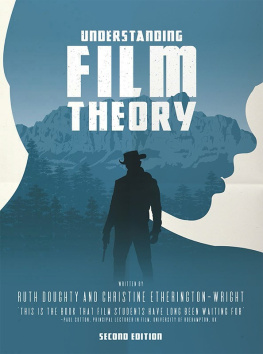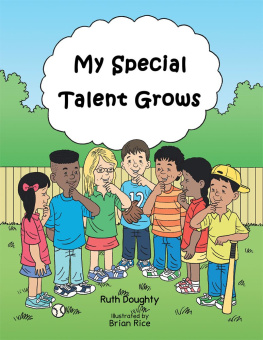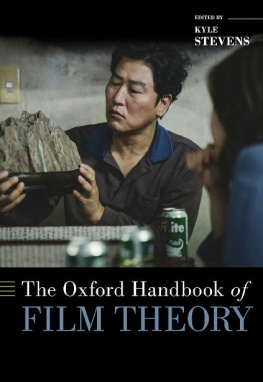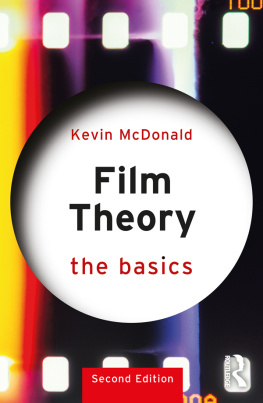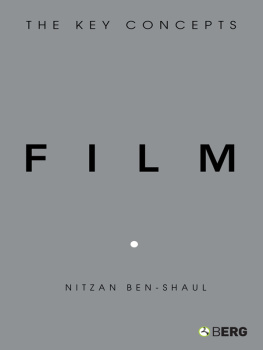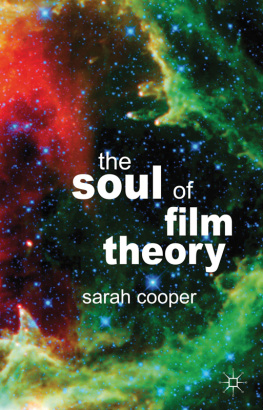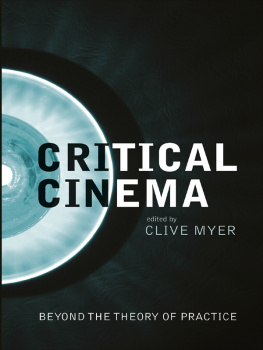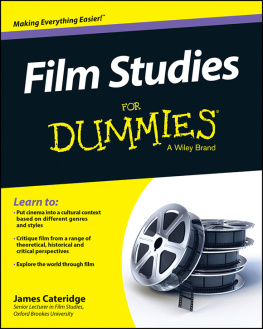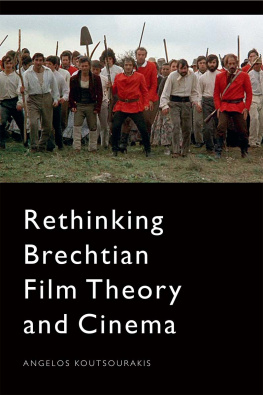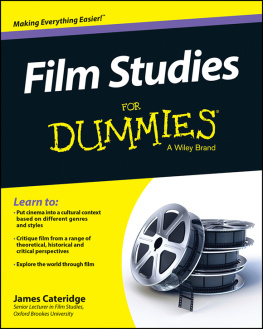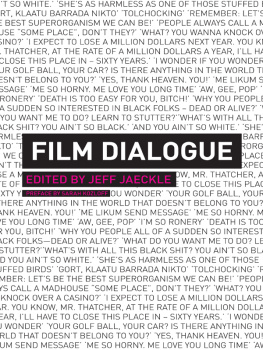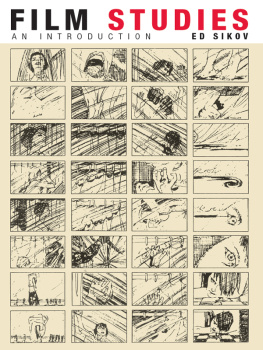UNDERSTANDING
FILM
THEORY
UNDERSTANDING
FILM
THEORY
RUTH DOUGHTY AND CHRISTINE ETHERINGTON - WRIGHT
SECOND EDITION

Ruth Doughty and Christine Etherington-Wright 2018
All rights reserved. No reproduction, copy or transmission of this publication may be made without written permission.
No portion of this publication may be reproduced, copied or transmitted save with written permission or in accordance with the provisions of the Copyright, Designs and Patents Act 1988, or under the terms of any licence permitting limited copying issued by the Copyright Licensing Agency, Saffron House, 610 Kirby Street, London EC1N 8TS.
Any person who does any unauthorized act in relation to this publication may be liable to criminal prosecution and civil claims for damages.
The authors have asserted their rights to be identified as the authors of this work in accordance with the Copyright, Designs and Patents Act 1988.
First published 2018 by
PALGRAVE
Palgrave in the UK is an imprint of Macmillan Publishers Limited, registered in England, company number 785998, of 4 Crinan Street, London, N1 9XW.
Palgrave and Macmillan are registered trademarks in the United States, the United Kingdom, Europe and other countries.
ISBN 9781137587947 hardback
ISBN 9781137528230 paperback
This book is printed on paper suitable for recycling and made from fully managed and sustained forest sources. Logging, pulping and manufacturing processes are expected to conform to the environmental regulations of the country of origin.
A catalogue record for this book is available from the British Library. A catalog record for this book is available from the Library of Congress.
CONTENTS
ILLUSTRATIONS
Paramount Pictures
Walt Disney Pictures
Universal Pictures
Universal Pictures
Revolution Studios/Dark Horse Entertainment
Estudios Picasso
Universal Pictures
First Studio Goskino
First Studio Goskino
First Studio Goskino
Twentieth Century-Fox. Courtesy the Kobal Collection
Paramount Pictures. Courtesy the Kobal Collection
Apjac Productions/Twentieth Century-Fox
Warner Brothers
Panthon Productions
RKO Radio Productions/Mercury Productions
Dino de Laurentiis Corporation/Universal Pictures
Touchstone Pictures
The Weinstein Company
courtesy of the Huntington Art Collections, San Marino, California. Photography 2015 Fredrik Nilsen
Lucasfilm Limited
RKO Radio Productions
Acknowledgements
We would like to thank the following people for their support and advice on the second edition of this book: Nicola Cattini, Ron Cowdry, Lincoln Geraghty, Sue Harper, Demelza Kooij, Lloyd Lang-man, Keith Marley, Rachel McLean, Sallie McNamara, Lydia Papadimitriou, Deborah Shaw, Corin Willis and Sara Wolstenholme Crompton.
Once more we would like to thank the students of Portsmouth University for their lively discussions and insights. We would also like to thank the students of Liverpool John Moores University who entered the debate and added Scouse humour.
Sincere thanks for the new case studies which feature in the second edition of Understanding Film Theory which were skilfully chosen and written by the following academics: Penny Chalk, Simon Hobbs, Keith Marley and Andrew Pope.
Finally, thanks as always to our partners and families:
To Barrie Etherington-Wright for putting up with the process once again and for his continuing support and belief in me. Also to Amanda and Paul for their enthusiasm and practical support of meals when deadlines loomed.
To Andrew Barnicoat, supplier of food, wine, vigorous debate, love and support. To Rhona and John Doughty for not tempting me out every weekend now I have moved back to the North West. Lastly, to Briony Barnicoat who has been telling all her friends that mummy has been writing a book about Frozen and The Lego Movie.
The authors and publishers would like to thank the copyright holders for permission to reproduce the following copyright material:
Journey of the Hero table in .
The British Board of Classification symbols in , courtesy of the British Board of Film Classification.
(The Blue Boy by Thomas Gainsborough, 1770), courtesy of the Huntington Art Collections, San Marino, California. Photography 2015 Fredrik Nilsen.
INTRODUCTION
Theory has a bad reputation. It often sends a shudder of despair down the spine of students and academics alike. The reasons for this are because it is challenging, it is difficult, it can take time to grasp and can often leave the reader feeling inadequate and frustrated. Theory can often seem old-fashioned and stuffy and therefore it can be hard to see its modern-day relevance. The aim of this book is to try to disassociate theory from these negative connotations. It is for this reason that the book has been written. In short, our intention is to take the fear out of theory.
What is theory?
Theory is a system of trying to understand and explain things from a specific point of view. Theories develop and evolve through debate and the interchange of ideas. For example, someone comes up with an idea which they share within academic circles (through journals, books, conference papers or online forums). This creates the basis for discussion and often vehement criticism. Over time ideas are questioned and more people contribute to the field of debate. As a result, theories should be thought of as chains of ideas and responses.
Interestingly, not all approaches to reading a film text are recognized as traditional theoretical modes. This can be attributed to hierarchical bias. For example, theories that developed out of philosophy and literary criticism have a long-established history and, for that reason, they are often granted the status of theory (Formalism, Structuralism, Marxism and Psychoanalysis). Alternatively, in the 1970s a number of new approaches emerged that were concerned with looking at groups that had previously been marginalized (Feminism, Queer Theory, Race and Ethnicity). As with all new ways of thinking, modern approaches are often met with controversy. However, this can fuel intellectual discussion and in turn can lead to new ideas. For example, our chapter on Masculinity can be read as a response to Feminist readings. In addition, a further widening occurred when film scholars began to use empirical research to inform their findings (Stars, Audience Research and Reception).
This division between which theories are traditionally classed as such and which may more appropriately be classed as critical perspectives is both reductive and redundant. All approaches are methodologies that enhance our understanding and appreciation of the film text. Which approaches earn the status of theory remains a contested notion and is to a large extent subjective. Nevertheless, Film Studies is a more recent academic pursuit, and as films are a modern cultural format, innovative theoretical ideas offer new and exciting lines of study.
Why study theory?
Theory can be interesting and exciting as it enriches our understanding of filmic texts. It can provide new ways of looking at some of our favourite films. More importantly, it can help us gain a new level of appreciation for texts that we feel we know inside out. Theory encourages debate as it enables different readings of texts; it provides another degree of interpretation. It can also offer a way of making sense of a film that may at first seem inaccessible such as avant-garde, surrealist filmmaking.
Theory can be difficult to comprehend and therefore it is important to invest a little time. Complex ideas cannot be understood and appreciated in a few minutes. Some theorists have spent their entire career debating and writing about one specific area; as a result it can be an arduous task trying to extract the intention of their theses. The process of finding that hidden nugget can be overwhelming. However, when the ideas finally fall into place, the light bulb moment is exciting, generating a huge sense of achievement and satisfaction.
Next page
